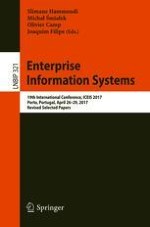2018 | Buch
Enterprise Information Systems
19th International Conference, ICEIS 2017, Porto, Portugal, April 26-29, 2017, Revised Selected Papers
herausgegeben von: Slimane Hammoudi, Michał Śmiałek, Olivier Camp, Joaquim Filipe
Verlag: Springer International Publishing
Buchreihe : Lecture Notes in Business Information Processing
